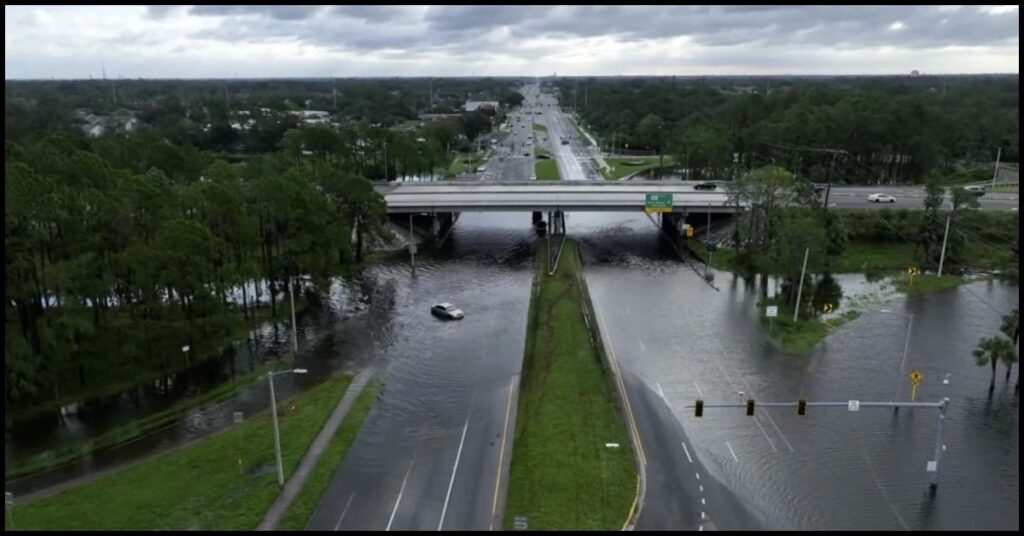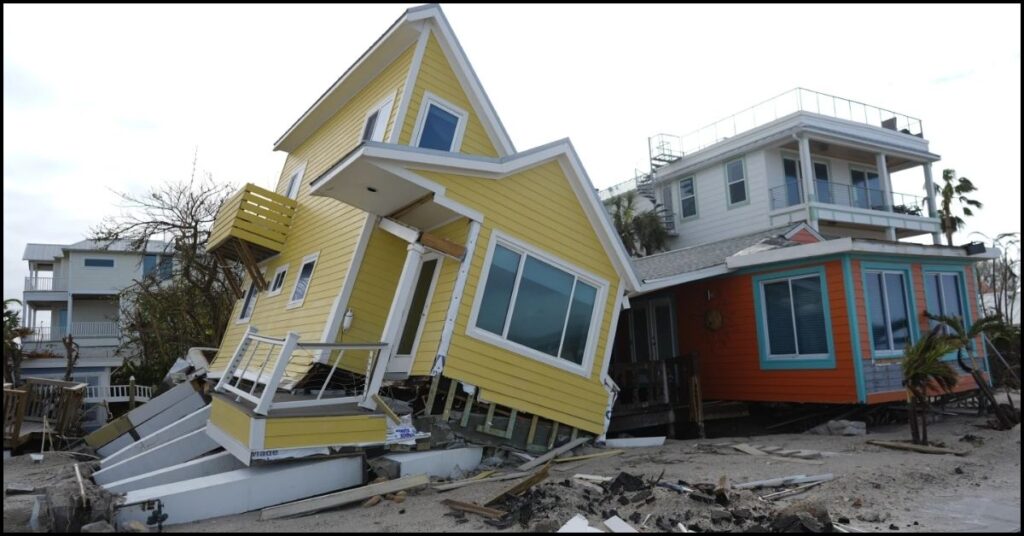According to the National Hurricane Center’s most recent advisory, Milton was a posttropical cyclone in the North Atlantic Ocean. About 70 miles (112 kilometers) south of Tampa, on Wednesday night, October 9, the storm made landfall as a Category 3 hurricane on Siesta Key after tracking southward in the last several hours. Rebuilding is worthwhile, according to locals, despite the ongoing threat.
Notable facts about Milton:
- St. Petersburg, Florida, had the highest total rainfall of 18.87 inches
- Egmont Channel, Florida, recorded the highest wind gust of 105 mph.
- In several locations in southwest Florida, like Naples and Fort Myers, the highest recorded storm surge was 5–6 feet. The numbers in Sarasota or Charlotte counties are probably larger, and this is probably understated.
- Milton was the fifth hurricane to hit the Gulf Coast this season.
- This season, Milton was the third hurricane to hit Florida.
- Milton was one of just nine other Atlantic storms to reach that wind threshold or above, with winds of 180 mph.
- It experienced the lowest pressure recorded in an Atlantic storm since Wilma in 2005, falling to 897 millibars.
- It’s also the fifth-lowest pressure that an Atlantic hurricane has ever experienced. There were 126 tornado warnings. This is the most tornado warning Florida has ever issued in a single day.
Path of Hurricane Milton:
From the Gulf of Mexico to the Atlantic Ocean, Hurricane Milton ripped over Florida, leaving mostly unharmed the heavily populated cities surrounding Tampa Bay but producing lethal tornadoes distant from the state’s center. A tropical disturbance that began in the western Caribbean Sea and developed in the Bay of Campeche on October 5 gave rise to Milton. Early on October 7, it became a hurricane after gradually intensifying as it headed eastward. Milton experienced explosive intensification later that day, reaching 180 mph (285 km/h) winds and becoming a Category 5 hurricane.
The cyclone weakened as it moved northeast toward Florida due to increasing wind shear, reaching Category 3 status before making landfall late on October 9 at Siesta Key. After that, Milton quickly deteriorated as it crossed the state and into the Atlantic Ocean. On October 10, it turned extratropical after becoming enmeshed in a frontal zone. On October 12, the remnants dissipated after progressively weakening and passing close to the island of Bermuda.

Image source: National Hurricane Centre
Climate Change and Hurricanes:
Destructive back-to-back hurricanes may become more frequent due to increasing sea levels and climate-driven risks, especially in regions like the Gulf Coast, according to research published last year in the journal Nature Climate Change.
NOAA predicted 17 to 25 named storms this year, with Milton being the 13th named storm of the hurricane season. Although the National Hurricane Center was not keeping an eye on any storm systems that were forming close to the United States as of Thursday, the next hurricane might be named Nadine.
State of Florida and back-back hurricanes:
In just two years, Milton is the fifth hurricane to strike the barrier islands. Phil Klotzbach, a senior research scientist at Colorado State University, said previous hurricanes to hit Florida were in 1871, 1886, 1964, 2004, and 2005.
According to Klotzbach, four hurricanes nearly reached shore in a single year in 2004. Ivan made landfall in Alabama, just west of the Alabama-Florida border, whereas Charley, Frances, and Jeanne made landfall in Florida.
Furious Winds by Milton:
The Egmont Channel saw gusts of up to 105 mph, Sarasota 102 mph, St. Petersburg 101 mph, Venice 97 mph, Tampa 93 mph, and Venice 90 mph. At an elevated station in Venice, a persistent wind speed of 78 mph was noted. Tropicana Field in St. Petersburg and several downtown cranes were severely damaged. The Mid-Florida Credit Union Amphitheater in Tampa was also destroyed.
Tornadoes after Milton Landfall
Before making landfall on Wednesday, Milton unleashed a number of tornadoes in southern and central Florida. At least three dozen tornadoes have been reported, but the National Weather Service won’t know the precise number of twisters until its storm surveys are complete. Over 20 tornadoes have been verified in Florida thus far.
Rainfall by Milton:
Southern Pinellas County, coastal Hillsborough County, and western Manatee County were saturated by rainfall totals ranging from 10 to 19 inches.

Image source: APnews
Parts of Florida’s Tampa Bay region received so much rain from Hurricane Milton that it was considered a once-in-1,000-year rainfall event. In just one hour, St. Petersburg, Florida, recorded over five inches of rain with a wind of up to 90 mph. Up to 17 inches of precipitation caused flooding in parts of downtown Tampa and St. Petersburg.
In a single day, Tampa received more than 11 inches of rain, breaking its monthly rainfall record. For more than a century, that record has been in place. Flooding brought on by rainfall was estimated to be waist deep in Tampa and St. Petersburg.
Deaths by Hurricane Milton:
Officials told CBS News that the storm claimed the lives of at least 24 individuals. Authorities said that tornadoes wrecked residences and killed five individuals at the Spanish Lakes Country Club near Fort Pierce on Florida’s Atlantic Coast. In Tampa, police also discovered a woman deceased beneath a fallen tree branch.
Authorities in Volusia County said that two women, a 54-year-old from Port Orange and a 79-year-old from Ormond Beach, were also killed when trees fell on houses.
Overall Destruction by Hurricane Milton:
Milton had a significant amount of wind damage, whereas Helene had primarily water damage, which is less likely to be covered. Homes were destroyed, trees were uprooted, trucks and boats were flung like toys, and roads were flooded by the hurricanes.

Image source: APnews
The financial services giant Moody’s estimated that the cumulative damage from the two storms would be between $20 billion and $34 billion. According to the Fitch credit rating agency, property damage from Hurricane Milton is expected to result in insured losses of between $30 billion and $50 billion, the biggest amount from a storm in two years. According to Karen Clark and Company, Milton’s insured losses alone came to $36 billion, while Helene’s were $6.4 billion.
According to a report by Fitch Ratings, that would raise the state’s insurers’ total annual insured losses to over $100 billion for the fifth consecutive year.
Disruption of Life by Hurricane Milton:
As people were ready for Milton’s possibly historic impact, mass evacuations caused traffic to back up on the roadways, which were then operating at 150 to 175% capacity.
Florida Lt. Gov. Jeanette Nuñez provided an update on Saturday, stating that the state responded to Milton by deploying the most national guardsmen in its history.
According to USA Today, the storm’s effects have forced the closure of at least nine airports in western Florida. These include two of the busiest airports in the United States, Orlando International Airport and Tampa International Airport, which together handled 39 million passengers in 2023.
According to poweroutage.us, Hurricane Milton caused 150 tornado warnings and cut off power to almost 3 million consumers. Areas where Milton made landfall, such as Pinellas, Hillsborough, Manatee, and Sarasota counties, saw the greatest number of disruptions.
Concerns of Mental Health Issues:
In addition to causing extensive loss and damage, two powerful hurricanes in a brief time have left a path of hopelessness and strained nerves that experts caution may increase the risk of depression and PTSD in many Floridians. One 2022 study found that those in Florida who experienced Hurricanes Irma and Michael in 2017 and 2018 had a higher likelihood of compounded mental health problems. Hurricanes and flooding bring on stress, anxiety, and sadness. Storms have the potential to cause or worsen pre-existing mental health issues. Furthermore, research suggests that mental health issues may be the largest health risk associated with flooding.
References
https://www.fema.gov/disaster/4834
https://www.usatoday.com/story/news/nation/2024/10/12/hurricane-milton-updates-saturday/75644638007
https://edition.cnn.com/weather/live-news/hurricane-milton-florida-10-09-24/index.html
https://apnews.com/live/hurricane-milton-florida-tracker-updates
https://www.cbsnews.com/live-updates/hurricane-milton-2024
https://www.nbcnews.com/weather/hurricanes/live-blog/hurricane-milton-live-updates-rcna174774

